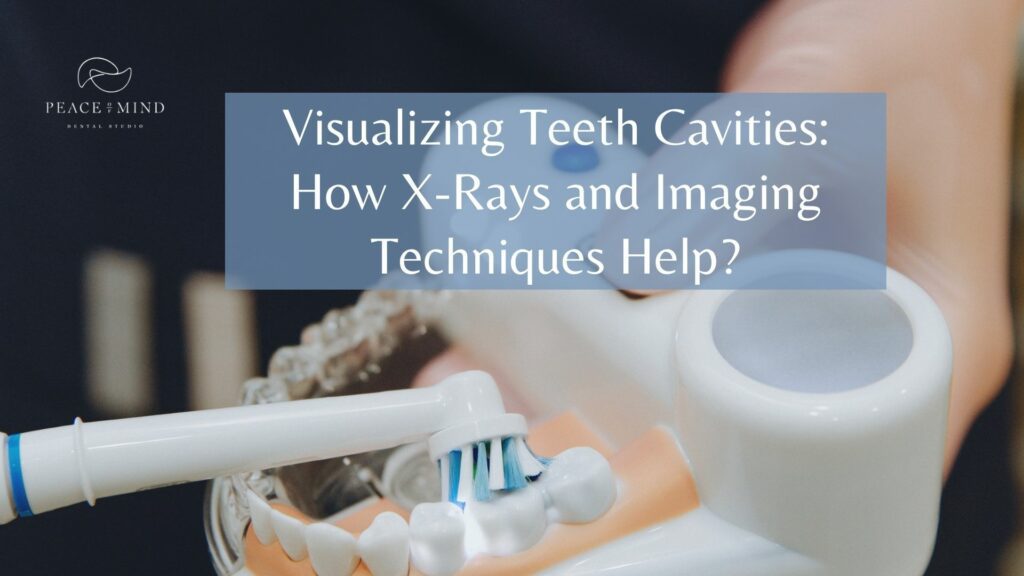
You might be someone who brushes his teeth regularly, and yet there is a greater possibility that you might have cavities. If the Centers for Disease Control and Prevention is to be believed, about 90% of adults aged 20 and older have at least one cavity.
The stats are terrifying, aren’t they? So, if you are wondering whether you have cavities, you must book an appointment with Peace of Mind Dental Studio, where we use dental imaging to derive high-definition dental cavity images and chart a course for effective treatment.
Book an appointment today!
Importance of Detecting and Treating Teeth Cavities
Dental cavities are small, visible, or invisible holes in your teeth that are caused by dental bacteria and acid. Bad eating habits, irregular oral hygiene practices, and genetic predisposition to dental problems can cause cavities. If left undetected, these cavities cause further decay and steal your flawless smile.
A teeth scan helps detect cavities, offering clear teeth cavity images and allowing for a proper treatment plan.
Why Visualizing Teeth Cavities is Important for Dental Health?
X-rays and dental imaging enable dentists to understand a tooth cavity’s exact location, size, and severity. It is vital information to formulate customized, appropriate treatment plans. The treatment for cavities ranges from simple fillings to tooth extraction due to severe decay.
Consult our expert dentists at Peace of Mind Dental Studio in Chandler if you suspect the presence of cavities.
Consequences of Untreated Cavities
Do you know that almost 26 percent of people in the US who have cavities don’t seek treatments for cavities? However, untreated cavities have grave consequences. It increases tooth sensitivity and results in severe tooth decay, toothache, and even complicated infections if root cavities are left untreated. It might reach the deeper tooth layers. You might even lose your teeth to cavities.
Types of Tooth Cavities
Here are the types of tooth cavities that you should know about to identify if you have any. However, it is only through dental cavity images that the invisible ones can be detected.
Pit and Fissure Cavities: This cavity type appears on the chewing surfaces of the teeth, especially on molars and premolars, as these teeth have depression and grooves where the food gets lodged and results in cavities over time.
Smooth Surface Cavities: This cavity type affects the smooth surface of your teeth, such as the incisors. Eating excessive salty and sugary snacks or consuming acidic foods might result in these.
Root Cavities: This cavity type affects your tooth at the root, where your tooth disappears beneath your gum. Gum recession and exposed root surfaces cause this cavity type.
How Effective Are Dental X-Rays for Dental Cavity Images?
Dental X-rays are considered a cornerstone for providing valuable insights into cavities that might not be detected during a routine dental examination. However, it is also possible that your cavities are so small that they might not appear in dental X-rays. It calls for advanced imaging techniques that modern dentists use to detect even the tiniest dental caries.
Advanced Imaging Techniques for Dental Cavities
Compared to dental X-rays, which are effective for several dental problems, advanced dental imaging techniques such as CT scans and digital radiography offer even more detailed and precise tooth cavity images. These technologies have enabled dentists to diagnose dental problems and plan complex dental procedures accurately.
Benefits of Dental Imaging
Here are certain dental imaging benefits that you must consider.
Early Detection: Advanced dental imaging techniques help detect dental cavities and other dental problems in their infancy to prevent further damage through prompt treatment.
Accurate Diagnosis: While routine examination is important, some problems might go undetected, which can be diagnosed with the help of dental imaging. Accurate diagnosis helps plan appropriate treatments tailored for individuals.
Preventive Care: By early detection of dental problems, one can focus on preventive care to avoid further damage.
Treatment Planning: Detailed imaging guides dentists in selecting the most suitable treatment options, ensuring efficient and effective care.
Fighting Cavities at Peace of Mind Dental Studio, Chandler
The introduction of dental imaging has proved to be a game-changer in dental care. Its multiple benefits have already been discussed in the blog above and must have helped you learn the importance of dental imaging in dentistry.
At Peace of Mind Dental Studio, Chandler, we aim to offer customized treatment plans for all our patients enabling them to smile confidently.
Consult us today for any of your dental concerns!
Frequently Asked Questions
Que: Are cavities reversible?
Ans: When the bacteria haven’t broken down the enamel in the early stages, it is possible to reverse cavities through enhanced dental care. However, once the cavities penetrate the deeper layers of the tooth, they require restorative treatments.
Que: What are different dental imaging techniques to detect dental cavities?
Ans: There are multiple dental imaging techniques that are presently used to detect dental caries, such as dental X—rays, bitewing X-rays, intraoral cameras, CT scans, etc.
Que: How do cavities reverse in the early stages?
Ans: There are ways to reverse the damage done by cavities in the early stages. You must change your dietary habits and start eating fresh fruits and vegetables rather than sugary and acid drinks and foods. Follow an effective dental hygiene routine, such as brushing and flossing teeth daily, rinsing mouth with mouthwash, etc. Consult dentists for dental filling for early-stage cavities.


